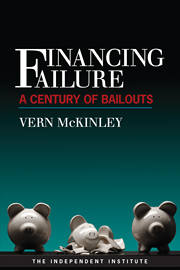The recent sound and fury regarding Richard Cordray’s appointment as head of the new Consumer Financial Protection Bureau, though justified, ignores much more crucial financial-reform issues. Three years after the explosion of bailouts in 2008-09, government has failed to address the underlying problems revealed during that period of panic-induced interventions.
The bailouts capped off multiple regulatory breakdowns as the financial agencies were caught off-guard by the rapid decline of regulated financial institutions and were negligent in their role as early-warning systems. Dodd-Frank’s answer was the creation of yet another new financial body, the Financial Services Oversight Council (FSOC). Never mind that there was a similar early-warning entity already in place since the late 1980s, the Working Group on Financial Markets. The FSOC was going to be bigger (10 member agencies instead of four), have more resources, more powers and receive more reports—the classic Washington formula to rectify government failure.
Just as the agencies failed to sound alarms, they were also far too secretive in shielding information about the “what” and “why” of their interventions (and non-interventions). We are just beginning to learn the extent to which their actions were an abysmal combination of seat-of-the-pants analysis and panicked responses. Decisions and deals oftentimes “took place in emergency meetings in the middle of the night,” as President Obama has described it, and the resulting decisions were inconsistent in their entirety. The answer in Dodd-Frank was a one-time review by the Government Accountability Office of the bailouts and a mandate on the Federal Reserve to publicly post details of its wide-ranging interventions. However, it did not include an effective means to shed light on future deliberations regarding interventions.
Finally, the bailouts left the status of large financial institutions such as Fannie Mae and Freddie Mac in doubt, leaving a cloud of uncertainty over the mortgage market. When Treasury Secretary Henry M. Paulson Jr. first pulled a team together to work on the bailout of Fannie and Freddie, he told his team that he did not want to “kick the can down the road.” However, that is exactly what he ended up doing, and Dodd-Frank did not even address the two mortgage giants.
Is there reason to think the new regulatory structure will work better? In the United States, few important financial institutions have failed in the last few years, but the examples we do have showed troubling signs, not only about regulatory breakdowns, but also the secretive nature of regulators and the lack of clear underlying analysis behind the decisions.
So how did the FSOC respond in the most recent meltdown of a large financial institution—MF Global—which filed for bankruptcy on Oct. 28? We know the FSOC deliberated on the issue. According to meeting minutes from Oct. 31, “The Council convened by teleconference to discuss developments regarding MF Global. Members of the Council provided oral reports.” The use of the term ‘minutes’ is generous here—a 1 1/2-page list of the names of the 28 people from the 10 underlying agencies, followed by five very short sentences about what they discussed for 29 minutes—would be a better description. So much for transparency on the council’s rationale for non-action. A review of the minutes from the prior FSOC meeting on Oct. 11 shows absolutely no similar before-the-fact reference to MF Global. So much for the concept of an early-warning system.
As for the lingering presence of Fannie Mae and Freddie Mac, which resulted in the costliest of the bailouts with a likely price tag in the hundreds of billions, we are told that politics have killed any chance of resolving their fate. The problem with that formulation is that the Federal Housing Finance Authority (FHFA), an independent agency that is regulator and conservator for the duo, can place them both into receivership, a procedure that would allow the two entities to be wound down.
In fact, the FHFA has had this power since before the Fannie and Freddie bailout and has never explained why it chose to put the two in conservatorship, the status that has allowed them to linger on indefinitely, rather than receivership. The FHFA could plan for a receivership by getting some help from the Federal Deposit Insurance Corp., which has placed hundreds of institutions into receivership during the most recent crisis, but have they? Unfortunately, this month the Federal Reserve has been pushing in the opposite direction of a wind-down by advocating that Fannie and Freddie do more to artificially bolster the mortgage market.
For all the rhetoric of reforming our financial system, the latest facts show no material progress to date.








